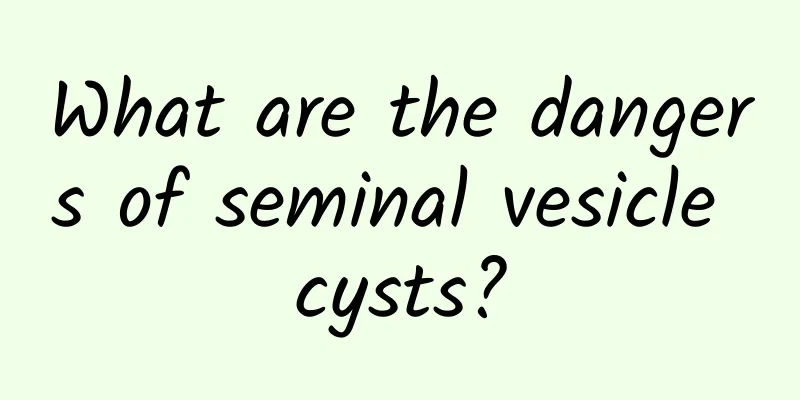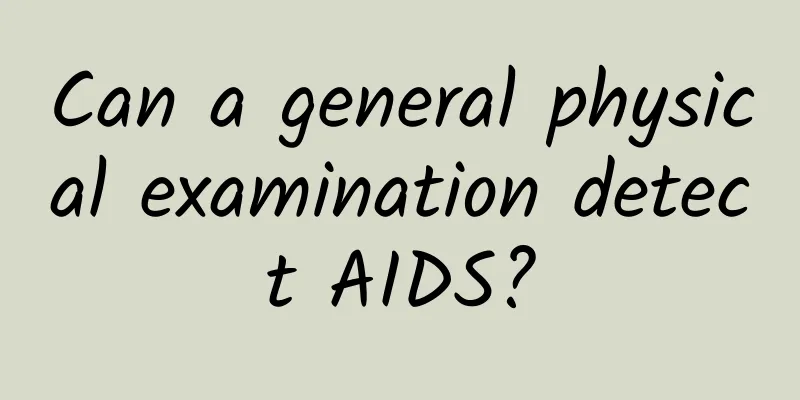What are the dangers of seminal vesicle cysts?

|
Everyone should know that some diseases often occur in the male body. For example, spermatocysts. The spermatocysts are the most important part of the male body to store sperm. However, once a disease problem occurs, it will affect the quality of male sperm and also affect the chances of female pregnancy. Therefore, we should pay attention to the treatment of spermatocysts, but we will also do things that are harmful to our health. What are the dangers of spermatocysts? Causes of spermatocyst The causes of spermatocyst cyst include: ① Inflammation. The most common are spermatocystitis and prostatitis, which often coexist. Most of them are bacterial infections, and mycoplasma infection should also be considered. ② Cysts, stones, tuberculosis or filariasis of the spermatocyst or prostate. ③ Varicose blood vessels or hemangiomas, flesh perforations, etc. on the posterior urethra or hypertrophic prostate. ④ Malignant tumors of the spermatocyst, prostate, and posterior urethra should be considered in people over 40 years old. The functional aspect is mainly due to long-term sexual restraint, excessive swelling of the spermatocyst, and excessive indulgence. Due to multiple contractions of the spermatocyst, the blood vessels in the spermatocyst mucosa rupture and bleed. Idiopathic hematospermia refers to some unexplained hematospermia. Symptoms of seminal vesicle cyst The appearance of hematospermia in patients with spermatocyst cyst is pink, dark red or brown, which can last for several years and is often without pain during ejaculation. It is more common in men aged 22 to 24 years old, with hematospermia as the first symptom and about 40% of visits for consultation; those with cysts and spermatocystolithiasis often have small stones discharged when bloody semen is discharged. Hematuria can be hematuria throughout the whole process, or it can be initial or final, especially hematuria after ejaculation. In addition to congenital abnormal development of the spermatocyst, infertility is also caused by narrowing or obstruction of the ejaculatory duct leading to oligospermia and asthenospermia. Long-term chronic spermatocyst cysts lead to atrophy of the spermatocysts, severe functional decline, and reduced fertility. Some patients also have chronic epididymitis, which affects sperm output. Dysuria is caused by the cyst pressing on the bladder neck and posterior urethra. The degree of dysuria is related to the size and location of the cyst. Treatment of seminal vesicle cyst Western medicine treatment of seminal vesicle cysts is determined based on the size of the cyst, clinical symptoms, and the presence or absence of complications. 1. Choose the right antibiotic Acute seminal vesiculocysts should be treated until the symptoms completely disappear, and then continue to take medication for 1 to 2 weeks; chronic seminal vesiculocysts need to continue taking medication for more than 4 weeks to consolidate the therapeutic effect. The second-generation cephalosporin, Cialis, and the quinolone, Ofuxing, are effective when applied intravenously. For seminal vesiculocysts caused by bacteria, antibiotics can be used to completely eliminate the bacteria that cause the seminal vesiculocysts from your body. Only after the test shows that the bacteria have indeed disappeared, can the medication be stopped. If the condition is more serious, such as urethral obstruction, hospitalization is required. 2. Cyst puncture Injecting anhydrous alcohol or tetracycline solution can shrink the cyst. 3.Surgery Surgical treatment is suitable for patients with large cysts, complicated by stones, obvious symptoms and difficult to cure. Methods include cystectomy or spermatocystectomy on the affected side, suprapubic "marsupial suture", and transurethral cystectomy. 4. Transurethral surgery For patients with spermatocyst cyst caused by ejaculatory duct stenosis or closure, transurethral ejaculatory duct incision or spermatocystectomy should be performed. 5. Conservative treatment Conservative treatment is suitable for patients with small cysts, mild symptoms, and young patients, and regular follow-up is required. For patients with concurrent infection and hematospermia, oral antibiotics and hemostatics should be given, and 5-a reductase inhibitors can be used if necessary. Prevention of seminal vesicle cysts 1. Avoid excessive sexual intercourse to reduce the degree of congestion in the sexual organs. 2. Live a regular life, combine work and rest, and avoid smoking, drinking, and spicy food. 3. Do a good job in the patients' ideological work, eliminate their worries, especially the worries of patients with hematospermia, and enhance their confidence in defeating the disease. 4. For the treatment of hematospermia, you can take diethylstilbestrol and prednisone orally 3 times a day for 2 to 3 weeks, which can usually stop the hematospermia. The dangers of seminal vesicle cysts 1. Hematospermia: The appearance of semen is pink, dark red or brown, which can last for several years, and there is often no pain during ejaculation. It is more common in men aged 22 to 24 years old, and hematospermia is the first symptom, accounting for about 40% of the visits to the doctor; those with cysts and seminal vesicle stones often have small stones discharged when they discharge bloody semen. 2. Hematuria: It can be whole-course hematuria, initial hematuria or final hematuria, especially the initial hematuria after ejaculation. 3. Dysuria: It is caused by the cyst pressing on the bladder neck and posterior urethra. The degree of dysuria is related to the size and location of the cyst. According to domestic reports, 9.1% of dysuria is caused by seminal vesicle cysts. When the cyst capacity reaches 400~, patients have bladder irritation symptoms such as frequent urination and urgency. 4. Male infertility: In addition to congenital abnormal development of the spermatocyst, there are also oligospermia caused by narrow or blocked ejaculatory ducts, and long-term chronic seminal vesiculitis, which leads to atrophy of the spermatocyst, severe functional decline, and reduced fertility. Some patients also have chronic epididymitis, which affects sperm output. According to domestic statistics, spermatocyst cysts and infertility account for 6.8%. Do these hazards affect you? Regardless of whether they do or not, as long as you have this disease, I suggest you go to the hospital for treatment immediately to avoid delaying the treatment of the disease. |
<<: Are the symptoms of seminal vesiculitis serious?
>>: What causes seminal vesiculitis?
Recommend
Is small testicles normal?
Small testicles may be caused by testicular hypop...
Is it harmful to have frequent erections without ejaculation?
Some male friends want to give their significant ...
The first private part of a man is actually this
It is common for men to strengthen their kidneys ...
Four changes are the key for men to improve sperm survival rate!
Sperm survival rate refers to the proportion of l...
What should men eat for back pain? Three foods can help relieve symptoms
Low back pain is a disease that most men have. Ge...
I came without masturbating
For men, moderate masturbation can help relieve p...
The ten major harms of smoking to men
Have you ever looked at the cigarette boxes caref...
What are the little fleshy thorns on the glans?
The male penis protrudes from the body surface, a...
Male lower right abdomen pain
I don't know why recently, but I've been ...
What causes morning erections?
I believe that every man has encountered such a s...
What supplements should men take when they feel tired?
Nowadays, people are under great pressure at work...
How to prevent premature ejaculation
Short sex time will definitely affect the quality...
Epididymitis that has not been cured for a long time
Epididymitis is a treatable disease. If after lon...
What to do with calf cramps? Treatment methods for calf cramps
Many people have experienced calf cramps. Sometim...
How to treat chronic prostatitis in men?
Regarding chronic prostatitis, everyone may think...









